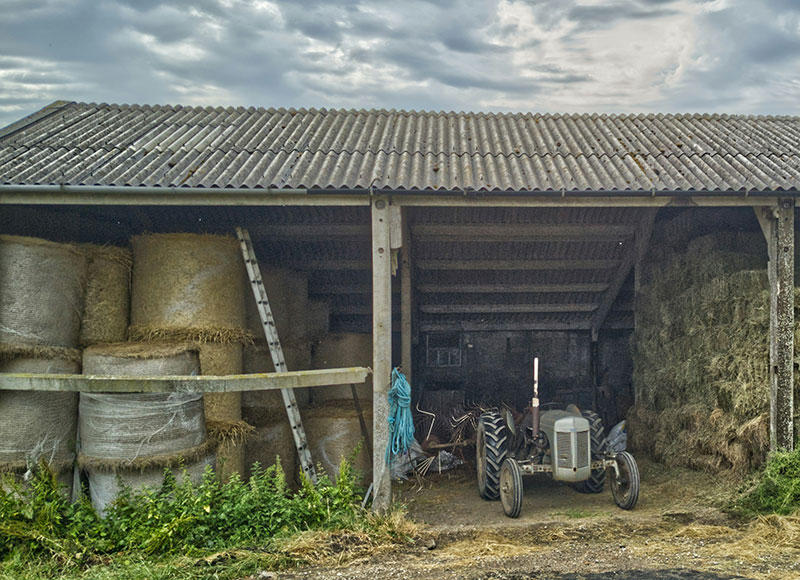What should you do if you find asbestos on a farm?
Asbestos has not been legal to use in UK construction since 1999, but this unfortunately does not make the known carcinogen a merely “historic” issue on UK farms. This shouldn’t necessarily be so surprising, given that a significant proportion of farm buildings up and down the country date from a time when asbestos was a widely used building material.
It is well known in the 2020s that the naturally occurring fibrous silicate mineral known as asbestos presents extremely serious health risks to those who breathe in or swallow its fibres. Such fibres can be released into the air if asbestos-containing materials (ACMs) are disturbed – for example, as a consequence of adverse weather events – or are allowed to deteriorate.
Once highly appreciated for such qualities as its relative affordability, availability, physical strength, and fire resistance, asbestos went on to be incorporated into a broad variety of products through the bulk of the 20th century. Those encompassed such items as cement sheets and panels, roofing materials, wall cladding and insulation, and gutters and pipes.
Today, asbestos may be banned in the UK, but the 1999 outlawing of the substance did not include an automatic requirement for ACMs to be removed from any and all sites in the country where they were already present. Even today, then, asbestos might be present on your farm – which means you need to know what to do if you spot potential ACMs.

What farm buildings and equipment are likely to contain asbestos?
This isn’t necessarily the simplest question to answer, as the exact asbestos situation can vary greatly from one farm to the next.
In short, however, asbestos can be present in a huge range of farm buildings, encompassing such typical structures as barns, storage sheds, and old farmhouses. One classic situation that can arise on many farms, is that of a shed sporting an asbestos cement roof, and perhaps some asbestos rainwater gutters.
However, it is worth noting that asbestos can also be present in certain farming equipment and machinery such as older tractors and combines, which may have asbestos-containing components. The substance may, for instance, be present in the brake linings of old vehicles, and there could be a risk of disturbing asbestos if you attempt to repair or replace such mechanical parts on these vehicles.
You should also be vigilant about the other elements of farm infrastructure – encompassing the likes of pipes, insulation, and roofing materials – in which asbestos might be found.
How can you identify asbestos materials on your farm?
An important principle to bear in mind is that you can never depend purely on visual inspection as a means of confirming whether particular materials are definitely asbestos-containing materials (ACMs). You will only be able to determine that certain materials contain asbestos by arranging to have a professional asbestos survey undertaken.
Nonetheless, it is crucial to know some of the classic visual signs that a specific material or product could be asbestos, as this knowledge will help you decide whether an asbestos survey will be needed.
With white asbestos – also known as chrysotile asbestos – being the type that was most frequently used on farms, you should keep a lookout for its light grey colour. Even this task, however, is complicated by the fact that white asbestos was sometimes mixed with blue (crocidolite) asbestos or brown (amosite) asbestos as pipe or boiler insulation.
Furthermore, the common names for different types of asbestos can be misleading. Blue asbestos, for instance, can range in hue from pale grey to deep blue, while brown asbestos can be such colours as pale grey and green. We have previously written extensively on what asbestos looks like, and how visual inspection can help you pick out ACMs.
It also helps to know some of the specific parts of buildings where asbestos might be seen on farms, such as in the panels between wallboards, in corrugated roofing and cladding, and in rainwater pipes and gutters.
Visible powdering or flaking on a worn or damaged surface could be a further indicator of the given material potentially being an ACM. So, this may give you another reason to urgently arrange for a professional asbestos survey to be carried out at your site.
What are the legal responsibilities of farm owners regarding asbestos?
The Control of Asbestos Regulations 2012, also known as CAR 2012, set out the stringent legal requirements that now apply to the management of asbestos in the UK. This includes in relation to any asbestos removal work that may be carried out at commercial premises such as a farm.
Regulation 4 of CAR 2012 stipulates that particular individuals – or “dutyholders” – have a “duty to manage” asbestos on premises for which they are responsible. Examples of “dutyholders” under this regulation include building owners, and individuals and organisations that have clear responsibility for a building’s maintenance or repair. So, if you are reading this as a farm owner, you can expect to be considered a “dutyholder” under this law.
If you are a dutyholder, you will be legally obliged to manage asbestos across all “non-domestic” properties for which you are responsible. In practice, this will probably mean all buildings on your farm except the house, which does not usually need to be included.
It will be expected that as the dutyholder, you will take reasonable steps to identify the location and condition of ACMs on your farm. You will need to ensure that a written plan is prepared showing where ACMs exist on your farm, and how they will be managed in order to prevent individuals from being exposed to asbestos. The plan will then need to be put into action, in addition to being communicated to affected individuals.
Furthermore, dutyholders such as farm owners are required to ensure the plan is reviewed regularly, and updated in accordance with any relevant change in circumstances.
You can learn more about these legal obligations under CAR 2012 by consulting the Health and Safety Executive (HSE)’s L143 document on Managing and working with asbestos.
What should you do if you find asbestos on your farm?
If, on the basis of the aforementioned visual identification tips, you find materials that you strongly suspect to be asbestos, you should carry out the following actions to begin managing the risks they could pose to human health (as well as to ensure compliance with your legal responsibilities).
Stop work and limit access
Immediately cease any work that might cause the possible asbestos to be disturbed, and restrict access to the area where the suspect material has been discovered, to help prevent exposure.
Avoid disturbing the suspected asbestos
Do not touch, move, or attempt to remove the materials that are suspected to contain asbestos. Any disturbance of ACMs can cause potentially harmful asbestos fibres to be released into the air, so it is crucial to ensure this does not occur.
Assess the situation
Without causing any disturbance to the possible asbestos materials, determine the extent to which asbestos seems to be present. Note the condition of the suspected ACMs, including whether they are intact or damaged, as this will inform the next steps you take.
Seek professional advice
Arrange for a professional asbestos surveyor to assess the situation. A thorough asbestos survey will not only enable you to confirm whether or not the suspect materials are, indeed, ACMs, but will also allow you to determine the type, amount, and condition of asbestos present.
Develop an asbestos management plan
Based on the results of the survey, work with professionals to develop an asbestos management plan. This plan should set out how the ACMs will be managed, contained, or removed, in order to keep people safe.
Notify relevant parties
Inform everyone on the farm who might be affected or who could potentially come into contact with the asbestos, about the ACMs that have been discovered. If you determine that it will be necessary to remove the ACMs from your farm, you should also engage the services of asbestos removal contractors who hold a licence from the HSE.
Implement safety measures
Put in place measures to ensure safety, as recommended by the asbestos professionals. Such steps may include the erection of signage and securing the area.
Arrange for professional removal (if necessary)
It might not be required in every case for ACMs on a farm to be removed. There may be an option to have the materials encapsulated, or to otherwise leave them in place, while arranging to manage and monitor their condition over time.
However, if you do conclude that complete asbestos removal is essential, you should make sure you only hire an HSE-licensed asbestos removal contractor. Whatever contractor you hire, they must follow strict safety and disposal regulations to prevent asbestos exposure and environmental contamination.
Conduct air monitoring
Once the ACMs have been removed, you should arrange to have the air quality in the given area tested by professionals. This will help ensure there are no lingering dangerous concentrations of asbestos fibres in the air, so that everyone can confidently and safely use the affected area again.
Maintain records
It is important – for reasons of both legal compliance and easy future reference – to keep detailed records of the asbestos presence at your farm, along with any assessments and/or removal actions carried out.
Review and update the asbestos management plan regularly
Regularly reviewing and updating your asbestos management plan to reflect any changes in the condition of the asbestos materials, will help ensure regulatory compliance as well as the most informed decisions on how the ACMs are managed over time.
Educate and train staff
Workers on your farm will need to be provided with training about the risks of asbestos, and your farm’s procedures for managing it. As part of this, you must ensure workers know who to notify in the event of them discovering any additional materials they suspect to be asbestos.
Conclusion: how can farmers stay safe and compliant?
We have sought to make clear in this article how crucial it is to identify, manage, and potentially remove asbestos from your farm, if the latter step turns out to be required.
Once you have spotted suspected asbestos, and confirmed the given materials to be ACMs, it is not just your initial actions that will be important – ongoing vigilance and the implementation of sustained and effective safety measures will also be critical. At all times, you should be striving to ensure you comply with the UK’s relevant health and safety regulations, including CAR 2012.
Following the steps we have outlined above will greatly aid your efforts to ensure safety and compliance at your farm when it comes to asbestos. To learn more about our own licensed and accredited asbestos services at Oracle Solutions, and to ask for a quote, please do not hesitate to contact our experts via phone or email.

Written by Jess Scott
Jess Scott has been an all-round asbestos consultant since 1996. That’s nearly 3 decades of asbestos knowledge. He spends his time sharing that knowledge with the team at Oracle and with their clients. Jess's goal is, and always has been, to use my expertise in helping people to comply with the law. This legal compliance ultimately helps to protect everyone from the harmful effects of asbestos. Jess has acted as an asbestos expert witness in legal cases and is involved in many asbestos educational activities throughout the UK.
